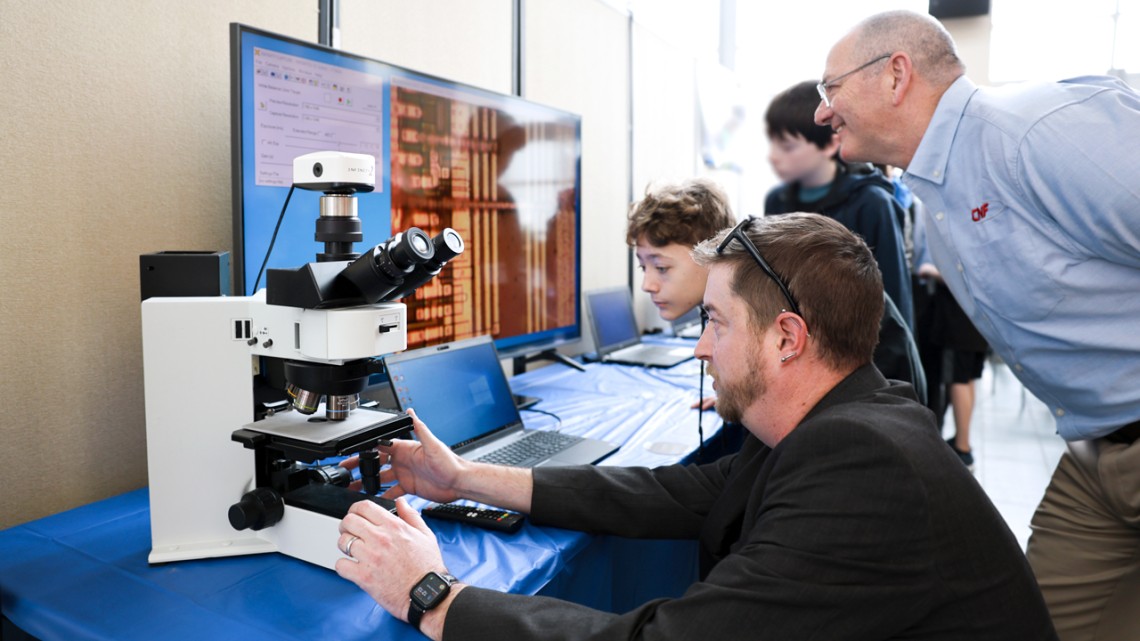
Tom Pennell, CNF education and outreach coordinator. shows a student from Liverpool Central School District how to use a microscope at Chip Camp on April 5, 2023. Ron Olson, CNF director of operations, looks on.
Cornell, Micron bring nanoscience to middle schoolers
By Laura Gallup, Cornell Chronicle
Nearly 120 Syracuse-area middle schoolers descended upon the Duffield Hall atrium on April 5 for a hands-on program designed to get kids excited about STEM.
The three-day Chip Camp was the result of a partnership between Liverpool, New York, Central School District (LCSD) and Micron, a computer memory chip manufacturer. The company plans to begin construction in 2024 on a semiconductor manufacturing facility in Clay, New York, potentially bringing tens of thousands of jobs to the region.
“Everything is connected back to technology in some way, and everything keeps changing and developing and becoming more effective and efficient,” said Kasey Dolson, the LCSD assistant superintendent for curriculum, instruction and assessment.
“And we want our students to not only be consumers, but creators, of technology and be involved in any kind of career or field in STEM,” Dolson said at the event.
LCSD middle schools hosted the first and third days of Chip Camp.
For Day Two, Chip Camp came to the university to visit the Cornell NanoScale Science and Technology Facility (CNF) for a crash course in the science of the very small. CNF, a world-class facility for micro and nanofabrication, operates as an open-user facility, allowing people from all over the world access to its cutting edge tools and machines.
The day started off with a presentation on items made at the nanoscale, such as chips for batteries, biomedical devices, computers, cell phones and cars, led by Tom Pennell, CNF education and outreach coordinator.
“If we don’t do this, we don’t have the next generation of scientists and kids who are inspired to pursue a career in this field,” Pennell said. “It’s incredibly important. So that’s the goal: to have fun and also to inspire and teach at the same time.”
He finished the session by carrying an iPad into a ‘clean room’ to broadcast himself to the auditorium getting suited up and walking through the facility.
After Pennell’s presentation, the students broke into three groups for activities.
At the first station, they used different types of microscopes to look at slides of tiny things such as horsehair, sardine scales and butterfly wings. At the second, kids drew on plastic and then printed their designs onto light sensitive paper using a UV light; they also made bracelets using beads that change color in sunlight.
“At every one of these events, I end up hearing my favorite quote, at least once.” Pennell said. “And that is, ‘That’s so cool.’ When you hear somebody say that, you know you’ve done a good job, you’ve inspired somebody. The look on their face sometimes is just wonderful, this awe that comes over them, like ‘I just did that.’”
At the last station, students dressed up in clean-room gear including suits, hairnets, boot covers and hoods to pose for selfies.
“Dressing up in the costumes and the selfie area was fun, to experience how to put everything on, and just the feeling in the suit,” said Michael Esposito, an 8th grader from Chestnut Hill Middle School.
Martin Sarkodee, a 7th grader from Morgan Road Middle School, had heard about Micron on television many times before the event, but didn’t know much about them, he said.
“This whole Chip Camp thing, it’s helped us more understand what Micron does, and their mission, their goal,” Sarkodee said. “It’s helped us understand technology better, and how to better use it to help our future.”
The first and third days of Chip Camp gave students the opportunity to launch rockets, learn to code and build robots. Dolson said that district teachers took Micron processes and turned them into activities that the students would understand. The whole experience, free for students, was made possible by a $40,000 grant from the Micron Foundation.
“I want all of our students to be excited about opportunities in STEM and have these experiences to do something different and unique, but also something cutting edge and new,” Dolson said. “I hope that by engaging our middle school students, this will help them have a better idea of what pathway they would like to take into high school and beyond our school walls.”
The company has been running Chip Camps near their other facilities for more than 20 years, and was excited to launch the first one in central New York, said Robert Simmons III, the Micron Foundation’s head of social impact and STEM programs.
“The success of this program is due in large part to the participation of partners like Cornell, who not only help provide programming to get young people excited about STEM,” Simmons said, “but also expose them to the vast array of opportunities that exist to pursue their dreams and passions.”
Media Contact
Abby Kozlowski
Get Cornell news delivered right to your inbox.
Subscribe
